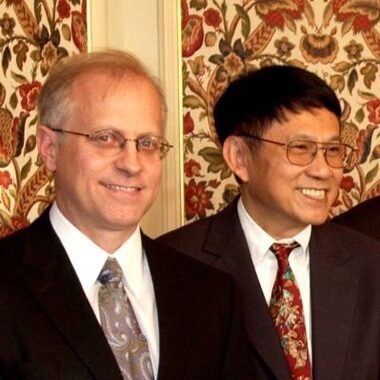Ho-kwang Mao: ein Porträt (englisch)
USA - USA/China
Russell Hemley und Ho-kwang Mao
Balzan Preis 2005 für Mineralphysik
Für ihre bahnbrechenden gemeinsamen Arbeiten über das Verhalten von Mineralien unter extremen physikalischen Bedingungen. Als produktives Team haben Russell Hemley und Ho-kwang Mao mit ihren Arbeiten bedeutungsvolle wissenschaftliche Beiträge auf höchstem Niveau geleistet. Sie haben Methoden entwickelt, welche die Untersuchung des Verhaltens verschiedenster Stoffe – wie Wasserstoff, des am weitesten verbreiteten “Minerals” des Universums – unter extremen Bedingungen von Druck und Temperatur erlauben. Die Ergebnisse der Arbeiten von Russell Hemley und Ho-kwang Mao sind für unser Verständnis der Natur und unserer Erde von grundlegender Bedeutung.
Ho-kwang (Dave) Mao has been pioneering high-pressure research and applications in physics and chemistry of Earth and planetary materials. He learned mineral physics and high-pressure diamond-anvil cell technology from his thesis advisors, William A. Bassett and Taro Takahashi, and started his four-decade career in this field. With Peter Bell at Carnegie Institution, he developed diamond cells reaching multimegabar static pressure. Later with Russell J. Hemley, he improved techniques to interface diamond cells with probes such as Mössbauer, fluorescence, Raman scattering, Brillouin scattering, crystal-field, visible to far-infrared transmission and reflection spectroscopies, electrical conductivity, synchrotron x-ray diffraction and x-ray spectroscopy. With laser-heated diamond cells, Mao and colleagues reached the P-T conditions of the Earth core, and studied the physics and chemistry of materials in the Earth’s deep interior: silicates, oxides, and iron-alloys, in order to construct geophysical and geochemical models based on real data. They have also studied the high P-T properties of planetary gases and ices to better understand the giant planets and their icy satellites. He has coauthored 620 papers.
Ho-kwang Mao was born in Shanghai, China in 1941. He moved to Taiwan at age seven, grew up there, and attended the Geology Department at National Taiwan University (B.S. 1963). After one-year of military service, he went to the US in 1964 for graduate studies at the Department of Geological Sciences, University of Rochester (M.S. 1966; Ph.D. 1968). He joined the Geophysical Laboratory, Carnegie Institution of Washington in 1968, and has worked there ever since. He is the recipient of the Gregori Aminoff Prize in Crystallography (2005) from the Royal Swedish Academy of Sciences, the Roebling Medal (2005), the Mineralogical Society of America Award (1979) from the Mineralogical Society of America, the Arthur L. Day Prize, a Lectureship (1990) from the US National Academy of Science and the P. W. Bridgman Gold Medal (1989) from the International Association for the Advancement of High Pressure Science & Technology (AIRAPT). He is an elected Member of the National Academy of Science (U.S.A.), Member of the Academia Sinica (Taiwan) and Foreign Member of the Chinese Academy of Sciences (China). He has been elected a Fellow of the American Geophysical Union, the American Physical Society, the European Association for Geochemistry, the Geochemical Society, and the Mineralogical Society of America.
(September 2005)
